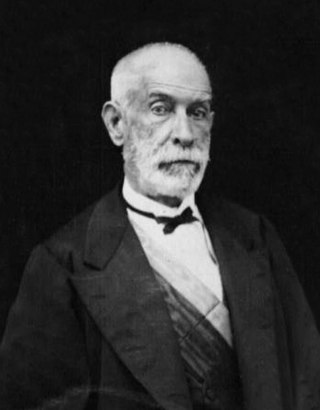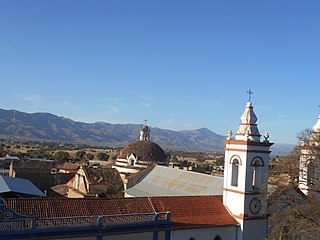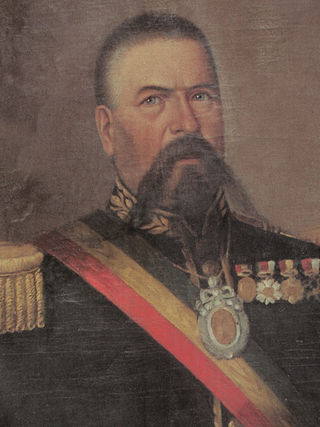| |||||
| Decades: | |||||
|---|---|---|---|---|---|
| See also: | Other events of 1871 History of Bolivia • Years | ||||
| |||||
| Decades: | |||||
|---|---|---|---|---|---|
| See also: | Other events of 1871 History of Bolivia • Years | ||||

Manuel Mariano Melgarejo Valencia was a Bolivian military officer and politician who served as the fifteenth president of Bolivia from December 28, 1864, until his fall on January 15, 1871.
Ladislao Cabrera was a Bolivian hero during the War of the Pacific. Born in Totora, Cochabamba Department, Carrasco Province, he is famous for organising the defence of Calama against the Chilean invaders in the War of the Pacific.

Tomás Frías Ametller was a Bolivian lawyer and politician who served as the 17th President of Bolivia twice nonconsecutively from 1872 to 1873 and from 1874 to 1876. Having graduated as a lawyer and worked as a merchant, he soon decided to enter the world of politics. His long political career began in 1831, when he was elected to represent Potosí in the Chamber of Deputies. This was followed by his first diplomatic posting when he was sent to France in Bolivia's first ever foreign delegation.

Hilarión Daza was a Bolivian military officer who served as the 19th president of Bolivia from 1876 to 1879. During his presidency, the infamous War of the Pacific started, a conflict which proved to be devastating for Bolivia.

Eliodoro Villazón Montaño was a Bolivian lawyer and politician who served as the 27th president of Bolivia from 1909 to 1913 and as the 15th vice president of Bolivia from 1904 to 1909.

Pedro Agustín Morales Hernández was a Bolivian military officer who served as the 16th president of Bolivia from 1871 to 1872.

Tarata is a town in Cochabamba Department, Bolivia. It is the capital of the Esteban Arze Province.

The Boundary Treaty of 1866 between Chile and Bolivia, also called the Mutual Benefits Treaty, was signed in Santiago de Chile on August 10, 1866, by the Chilean Foreign Affairs Minister Alvaro Covarrubias and the Bolivian Plenipotentiary in Santiago Juan R. Muñoz Cabrera. It drew, for the first time, the border between both countries at the 24° South parallel from the Pacific Ocean to the eastern border of Chile and defined a zone of bipartite tax collection, the "Mutual Benefits zone", and tax preferences for articles from Bolivia and Chile.

Dr. Daniel Nuñez del Prado was a revolutionary Bolivian doctor of medicine. His parents were Dr Maria José Nuñez del Prado and Isabel del Valle. His brother, Eduardo Nuñez del Prado, was also a doctor of medicine.
Events in the year 1869 in Bolivia.

Belisario Salinas Belzu was a Bolivian lawyer, teacher, and politician who served as the fifth vice president of Bolivia from 1880 to 1884. He served as second vice president alongside first vice president Aniceto Arce during the administration of Narciso Campero.

Rafael Peña de Flores was a Bolivian lawyer, teacher, naturalist, and politician who served as the 11th vice president of Bolivia from 1896 to 1899. He served as first vice president alongside second vice president Jenaro Sanjinés during the administration of Severo Fernández.

The Melgarejo Cabinet constituted the 30th cabinet of the Republic of Bolivia. It was formed on 19 June 1867 after Mariano Melgarejo was installed as the 15th president of Bolivia following the coup d'état, succeeding the Achá Cabinet. It was dissolved on 15 January 1871 upon Melgarejo's overthrow in another coup d'état and was succeeded by the Cabinet of Agustín Morales.

The Morales Cabinet constituted the 31st to 32nd cabinets of the Republic of Bolivia. It was formed on 22 June 1871 after Agustín Morales took power in a coup d'état, succeeding the Melgarejo cabinet. It was dissolved on 27 November 1872 when Morales was assassinated. All Ministers of State were ratified in their positions by the new cabinet formed by Morales' successor Tomás Frías.

José María Calderón, also known as el Cachorro, was a Bolivian military officer. Known to be brave in the battlefield, he rose through the ranks and eventually aligned himself with the dictatorship of Mariano Melgarejo. José María de Achá would sentence Calderón to death in 1861. In order to avoid the sentence, Calderón fled to the Bolivian interior where he spent years in the Llanos de Moxos.

Severo Melgarejo Rojas was a Bolivian military officer, business man and guano magnate. He was the son of the President of Bolivia, Mariano Melgarejo, and his wife Rosa Rojas. He was considered a traitor by most Bolivians of his day due to his Chilean citizenship.

Ildefonso Sanjinés Rada was a Bolivian military officer who served as Minister of War twice during the presidencies of Agustín Morales, Tomás Frías, and Adolfo Ballivián. Sanjinés served during the War of the Confederation and the Peruvian-Bolivian War of 1841-1842, fighting valiantly during the Battle of Ingavi.

Quintín Quevedo Ferrari was a Bolivian military officer who rose to prominence after aiding Mariano Melgarejo in the overthrow of President José María de Achá in 1864. He was also a famous and early explorer of the Bolivian Amazon, exploring the Madeira River and the Beni savannah frontier. In 1872 he launched an invasion from Valparaíso, Chile, resulting in an international crisis which is believed to have led to a secret alliance treaty between Peru and Bolivia against Chile. Said alliance became effective with the Chilean occupation of Antofagasta and the Bolivian Litoral Department, leading to the War of the Pacific.
Lieutenant Colonel Manuel Terrazas Vargas was a Bolivian military officer who served during the War of the Pacific. He was the cousin of Mariano Ricardo Terrazas, a famous Bolivian writer and educator.

Melchor Terrazas Virreira was a Bolivian politician and statesman who served as Minister of Government and Foreign Affairs and also as Minister of Justice, Public Instruction, and Worship during the presidencies of Tomás Frías and Agustín Morales. A lawyer and educator, he was an advocate for democratic, civilian governments and opposed caudillismo.